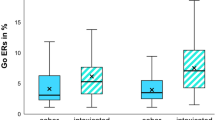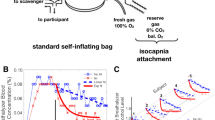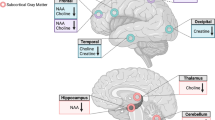Abstract
Proton magnetic resonance spectroscopy was used at 3T to measure the uptake and clearance of brain ethanol in rats after bolus intraperitoneal (i.p.) or intragastric (i.g.) alcohol injection, and to estimate the effects of acute alcohol on brain metabolites. The observation duration was 1–1.5 h with temporal resolution of alcohol sampling ranging from 4 s–4 min. The observed time course of alcohol brain concentration followed a consistent pattern characterized by a rapid absorption, an intermediate distribution, and a slower clearance that approached a linear decay. In a sample of eight healthy Wistar rats, the intercept of the linear clearance term, extrapolated back to the time of injection, correlated well with the administered dose per unit of lean body mass. Alcohol concentration estimation based on spectroscopically measured clearance was compared with blood alcohol levels from blood samples at the end of observation, and were in good agreement with the administered dose. Serial proton spectroscopy measurements provide a valid in vivo method for quantifying brain alcohol uptake and elimination kinetics in real time.
Similar content being viewed by others
Log in or create a free account to read this content
Gain free access to this article, as well as selected content from this journal and more on nature.com
or
References
Adalsteinsson E, Hurd RE, Mayer D, Sailasuta N, Sullivan EV, Pfefferbaum A (2004). In vivo 2D J-resolved magnetic resonance spectroscopy of rat brain with a 3T clinical human scanner. Neuroimage 22: 381–386.
Akoka S, Barantin L, Trierweiler M (1999). Concentration measurement by proton NMR using the ERETIC method. Ann Chem 71: 2554–2557.
Becker HC (1998). Kindling in alcohol withdrawal. Alcohol Health & Research World 22: 25–33.
Becker HC (2000). Animal models of alcohol withdrawal. Alcohol Research Health 24: 105–113.
Chronik B, Alejski A, Rutt BK (2000a). Design and fabrication of a three-axis multilayer gradient coil for magnetic resonance microscopy of mice. Magma 10: 131–146.
Chronik BA, Alejski A, Rutt BK (2000b). Design and fabrication of a three-axis edge ROU head and neck gradient coil. Magn Reson Med 44: 955–963.
Dahchour A, De Witte P (2003). Excitatory and inhibitory amino acid changes during repeated episodes of ethanol withdrawal: an in vivo microdialysis study. Eur J Pharmacol 459: 171–178.
De Witte P (2004). Imbalance between neuroexcitatory and neuroinhibitory amino acids causes craving for ethanol. Addictive Behavior 29: 1325–1339.
Dreher W, Leibfritz D (1995). On the use of two-dimensional-J NMR measurements for in vivo proton MRS: measurement of homonuclear decoupled spectra without the need for short echo times. Magn Reson Med 34: 331–337.
Dreher W, Leibfritz D (1999). Detection of homonuclear decoupled in vivo proton NMR spectra using constant time chemical shift encoding: CT-PRESS. Magn Reson Imaging 17: 141–145.
Durazzo TC, Gazdzinski S, Banys P, Meyerhoff DJ (2004). Cigarette smoking exacerbates chronic alcohol-induced brain damage: a preliminary metabolite imaging study. Alcoholism—Clin Exp Res 28: 1849–1860.
Erickson CK (1976). Regional distribution of ethanol in the rat brain. Life Sci 19: 1439–1446.
Fein G, Meyerhoff DJ (2000). Ethanol in human brain by magnetic resonance spectroscopy: correlation with blood and breath levels, relaxation, and magnetization transfer. Alcoholism—Clin Exp Res 24: 1227–1235.
Fein G, Meyerhoff DJ, Weiner MW (1995). Magnetic resonance spectroscopy of the brain in alcohol abuse. Alcohol Health Res World 19: 3056–3314.
Foster-Gareau P, Heyn C, Alejski A, Rutt BK (2003). Imaging single mammalian cells with a 1.5 T clinical MRI scanner. Magn Reson Med 49: 968–971.
Grant SA, Millar K, Kenny GN (2000). Blood alcohol concentration and psychomotor effects. Br J Anaesthesia 85: 401–406.
Haase A, Frahm J, Hanicke W, Matthaei D (1985). 1H NMR chemical shift selective (CHESS) imaging. Phys Med Biol 30: 341–344.
Hahn RG, Norberg A, Jones AW (1997). ‘Overshoot’ of ethanol in the blood after drinking on an empty stomach. Alcohol Alcohol 32: 501–505.
Hanstock CC, Rothman DL, Shulman RG, Novotny EJ, Petroff OAC, Prichard JW (1990). Measurement of ethanol in the human brain using NMR spectroscopy. J Stud Alcohol 51: 104–107.
Hetherington H, Telang F, Pan J, Sammi M, Schuhlein D, Molina P et al (1999). Spectroscopic imaging of the uptake kinetics of human brain ethanol. Magn Reson Med 42: 1019–1026.
Heyn C, Bowen CV, Rutt BK, Foster PJ (2005). Detection threshold of single SPIO-labeled cells with FIESTA. Magn Reson Med 53: 312–320.
Hurd R, Sailasuta N, Srinivasan R, Vigneron DB, Pelletier D, Nelson SJ (2004). Measurement of brain glutamate using TE-averaged PRESS at 3T. Magn Reson Med 51: 435–440.
Hurd RE (2000). Magnetic resonance spectroscopic imaging having reduced parasitic side band signals. United States Patent no. 6 069 478, May 30, 2000.
Hurd RE, Gurr D, Sailasuta N (1998). Proton spectroscopy without water suppression: the oversampled J-resolved experiment. Magn Reson Med 40: 343–347.
Kalant H (1971). Absorption, diffusion, distribution and elimination of ethanol: effects on biological membranes. In: Kissin B, Begleiter H (eds). The Biology of Alcoholism. Plenum Press: New York. pp 1–62.
Kalant H (2000). Effects of food and body composition on blood alcohol curves. Alcoholism—Clin Exp Res 24: 413–414.
Kaufman MJ, Chiu TM, Mendelson JH, Woods BT, Teoh SK, Eros-Sarnyai M et al (1996). Brain alcohol detectability increase with repeated administration in humans: a proton spectroscopy study. Magn Reson Med 35: 435–440.
Koob GF (2000). Neurobiology of addiction. Toward the development of new therapies. Ann NY Acad Sci 909: 170–185.
Krystal JH, Petrakis IL, Mason G, Trevisan L, D'Souza DC (2003). N-methyl-D-aspartate glutamate receptors and alcoholism: reward, dependence, treatment, and vulnerability. Pharmacol Therapeu 99: 79–94.
Lee H, Holburn GH, Price RR (2003). Proton MR spectroscopic studies of chronic alcohol exposure on the rat brain. J Magn Reson Imaging 18: 147–151.
Li TK, Beard JD, Orr WE, Kwo PY, Ramchandani VA, Thomasson HR (2000). Variation in ethanol pharmacokinetics and perceived gender and ethnic differences in alcohol elimination. Alcoholism—Clin Exp Res 24: 415–416.
Li TK, Lumeng L, McBride WJ, Waller MB (1979). Progress toward a voluntary oral consumption model of alcoholism. Drug Alcohol Depend 4: 45–60.
Lovinger DM (2002). NMDA receptors lose their inhibitions. Nat Neurosci 5: 614–616.
Mayer D, Spielman DM (2005). Detection of glutamate in the human brain at 3T using optimized constant time point resolved spectroscopy. Magn Reson Med 54: 439–442.
Melendez RI, Hicks MP, Cagle SS, Kalivas PW (2005). Ethanol exposure decreases glutamate uptake in the nucleus accumbens. Alcoholism—Clin Exp Res 29: 326–333.
Moghaddam B, Bolinao ML (1994a). Biphasic effect of ethanol on extracellular accumulation of glutamate in the hippocampus and the nucleus accumbens. Neurosci Lett 178: 99–102.
Moghaddam B, Bolinao ML (1994b). Glutamatergic antagonists attenuate ability of dopamine uptake blockers to increase extracellular levels of dopamine: implications for tonic influence of glutamate on dopamine release. Synapse 18: 337–342.
Nebendahl K (2000). Routes of administration. In: Krinkle GJ (ed). The Handbook of Experimental Animals: The Laboratory Rat. Academic Press: San Diego. pp 463–483.
Neumark YD, Friedlander Y, Durst R, Leitersdorf E, Jaffe D, Ramchandani VA et al (2004). Alcohol dehydrogenase polymorphisms influence alcohol-elimination rates in a male Jewish population. Alcoholism—Clin Exp Res 28: 10–14.
O'Connor S, Morzorati S, Christian J, Li TK (1998). Clamping breath alcohol concentration reduces experimental variance: application to the study of acute tolerance to alcohol and alcohol elimination rate. Alcoholism—Clin Exp Res 22: 202–210.
Parks MH, Dawant BM, Riddle WR, Hartmann SL, Dietrich MS, Nickel MK et al (2002). Longitudinal brain metabolic characterization of chronic alcoholics with proton magnetic resonance spectroscopy. Alcoholism—Clin Exp Res 26: 1368–1380.
Petroff OAC, Novotny EJ, Ogino T, Avison M, Prichard JW (1990). In vivo measurements of ethanol concentration in rabbit brain by 1H magnetic resonance spectroscopy. J Neurochem 54: 1188–1195.
Pfefferbaum A, Adalsteinsson E, Sullivan EV (2004). In vivo structural imaging of the rat brain with a 3T clinical human scanner. J Magn Reson Imaging 20: 779–785.
Ramchandani VA, Bolane J, Li TK, O'Connor S (1999). A physiologically-based pharmacokinetic (PBPK) model for alcohol facilitates rapid BrAC clamping. Alcoholism—Clin Exp Res 23: 617–623.
Roberto M, Schweitzer P, Madamba SG, Stouffer DG, Parsons LH, Siggins GR (2004). Acute and chronic ethanol alter glutamatergic transmission in rat central amygdala: an in vitro and in vivo analysis. J Neurosci 24: 1594–1603.
Rooney WD, Lee JH, Li X, Wang GJ, Franceschi D, Springer Jr CS et al (2000). 4.0T water proton T1 relaxation times in normal human brain and during acute ethanol intoxication. Alcoholism—Clin Exp Res 24: 830–836.
Rossetti ZL, Carboni S (1995). Ethanol withdrawal is associated with increased extracellular glutamate in the rat striatum. Eur J Pharmacol 283: 177–183.
Sammi MK, Pan JW, Telang FW, Schuhlein D, Molina PE, Volkow ND et al (2000). Measurements of human brain ethanol T(2) by spectroscopic imaging at 4T. Magn Reson Med 44: 35–40.
Schweinsburg BC, Taylor MJ, Alhassoon OM, Videen JS, Brown GG, Patterson TL et al (2001). Chemical pathology in brain white matter of recently detoxified alcoholics: a 1H magnetic resonance spectroscopy investigation of alcohol-associated frontal lobe injury. Alcoholism—Clin Exp Res 25: 924–934.
Seitz D, Widmann U, Seeger U, Nagele T, Klose U, Mann K et al (1999). Localized proton magnetic resonance spectroscopy of the cerebellum in detoxifying alcoholics. Alcoholism—Clin Exp Res 23: 158–163.
Selim M, Bradberry CW (1996). Effect of ethanol on extracellular 5-HT and glutamate in the nucleus accumbens and prefrontal cortex: comparison between the Lewis and Fischer 344 rat strains. Brain Res 716: 157–164.
Spielman DM, Glover GH, Macovski A, Pfefferbaum A (1993). Magnetic resonance spectroscopic imaging of ethanol in the human brain: A feasibility study. Alcoholism—Clin Exp Res 17: 1072–1077.
Srinivasan R, Sailasuta N, Hurd R, Nelson S, Pelletier D (2005). Evidence of elevated glutamate in multiple sclerosis using magnetic resonance spectroscopy at 3T. Brain 128: 1016–1025.
Tabakoff B, Hoffman PL (1996). Alcohol addiction: an enigma among us. Neuron 16: 909–912.
Webb P, Sailasuta N, Kohler S, Raidy T, Moats R, Hurd R (1994). Automated single-voxel proton MRS: technical development and multisite verification. Magn Reson Med 31: 365–373.
Widmark EMP (1981, originally published 1932). Principles and applications of medicolegal alcohol determination. Biomedical Publications: Davis, CA.
Yan QS, Reith ME, Yan SG, Jobe PC (1998). Effect of systemic ethanol on basal and stimulated glutamate releases in the nucleus accumbens of freely moving Sprague-Dawley rats: a microdialysis study. Neurosci Lett 258: 29–32.
Acknowledgements
We acknowledge Drs William McBride and Richard Bell of the University of Indiana, who kindly supplied the animals; Marcus Alley, PhD and David Clayton, PhD for construction and calibration of the custom head coil; Diane Howard, RVT and Wendy Baumgardner, RVT, LATg, Veterinary Research Technologists, who administered anesthesia and caringly monitored the animals during scanning; Ralph Hurd, PhD and Napapon Sailasuta, PhD for scanner software support; Alexander Jack, BA, Daniel J Pfefferbaum, BA and Andrea Spadoni, BA for assistance in scan acquisition; Shay Cook, Luke Garcia, and Juan Orduna, animal technicians, who provided thoughtful care for the animals. This study was supported by grants from the National Institute on Alcohol Abuse and Alcoholism (INIA—AA13521; AA05965).
Author information
Authors and Affiliations
Corresponding author
Rights and permissions
About this article
Cite this article
Adalsteinsson, E., Sullivan, E., Mayer, D. et al. In Vivo Quantification of Ethanol Kinetics in Rat Brain. Neuropsychopharmacol 31, 2683–2691 (2006). https://doi.org/10.1038/sj.npp.1301023
Received:
Revised:
Accepted:
Published:
Issue date:
DOI: https://doi.org/10.1038/sj.npp.1301023
Keywords
This article is cited by
-
Dose-dependent metabolite changes after ethanol intoxication in rat prefrontal cortex using in vivo magnetic resonance spectroscopy
Scientific Reports (2019)
-
Adolescent binge-like alcohol alters sensitivity to acute alcohol effects on dopamine release in the nucleus accumbens of adult rats
Psychopharmacology (2016)
-
Magnetic Resonance Imaging Biomarkers in Patients with Progressive Ataxia: Current Status and Future Direction
The Cerebellum (2013)
-
Differential Effects of the Dual Orexin Receptor Antagonist Almorexant and the GABAA-α1 Receptor Modulator Zolpidem, Alone or Combined with Ethanol, on Motor Performance in the Rat
Neuropsychopharmacology (2011)
-
The Density Difference of Cupula and Endolymph Changes the Mechanics of Semicircular Canals
Microgravity Science and Technology (2011)



